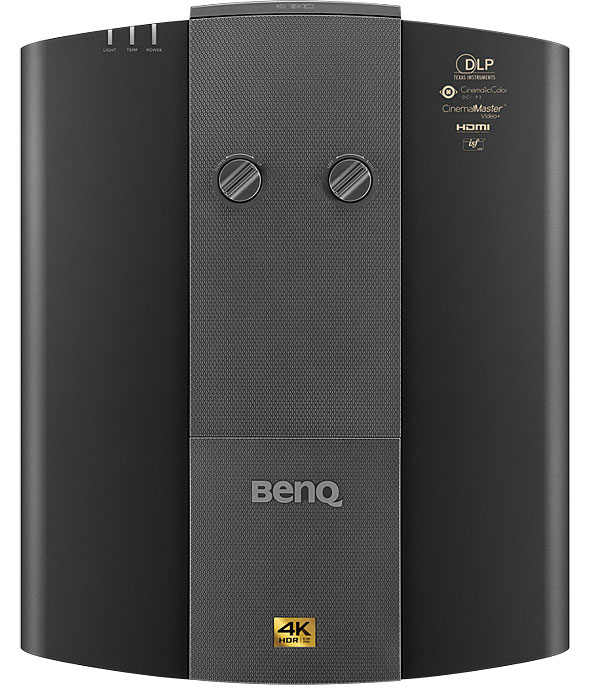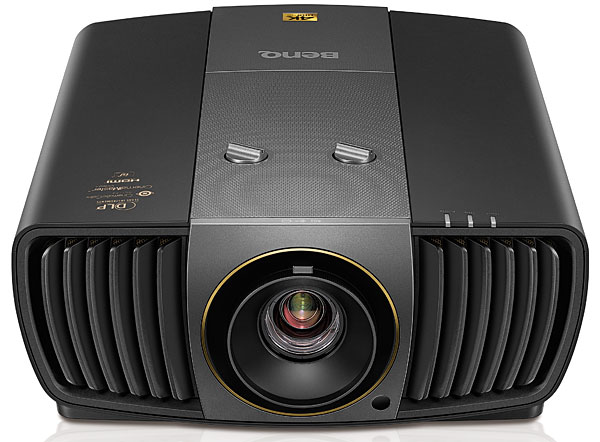BENQ HT9060 DLP Projector Review Page 2
HDR setup options on the HT9060 proved limited compared with the new HDR-capable projectors on the market today. While BenQ's previous flagship only featured a wide color gamut setting for DCI-P3, a format used in professional mastering environments and digital cinemas that isn't part of consumer standards, this model features a Rec. 2020 color mode that tracks colors properly. Coverage of the P3 portion of the Rec. 2020 color gamut measured around 97 percent—an excellent result. Unlike other projector designs we've tested, the BenQ does not require a filter in its LED light engine path to achieve a wider gamut. However, selecting the HT9060's Rec. 2020 color gamut option in HDR mode did result in a measured 10 percent loss of light output.
 On the HDR tone mapping front, BenQ provides an HDR Brightness adjustment with settings between -2 and +2 to select the overall clipping point (and the balance of the tone map). I found this to be similar to "Contrast HDR" on Sony projectors, a setting that defines the upper end of the tone map and then adjusts the curve to it. The upper white point with HDR Brightness varies from 300 nits at +2 to 1,000 nits at -2. Unfortunately, BenQ doesn't give you much range to work with: while most HDR content is around 1,000 nits or less, there are lots of titles with a MaxCLL (peak pixel value of the displayed content) well above 1,000 nits, and playback of these will result in noticeable clipping. And since the setting isn't adaptive, users will need to adjust the value on a title-by-title basis if they see artifacts like clipping or scenes that are too dark.
On the HDR tone mapping front, BenQ provides an HDR Brightness adjustment with settings between -2 and +2 to select the overall clipping point (and the balance of the tone map). I found this to be similar to "Contrast HDR" on Sony projectors, a setting that defines the upper end of the tone map and then adjusts the curve to it. The upper white point with HDR Brightness varies from 300 nits at +2 to 1,000 nits at -2. Unfortunately, BenQ doesn't give you much range to work with: while most HDR content is around 1,000 nits or less, there are lots of titles with a MaxCLL (peak pixel value of the displayed content) well above 1,000 nits, and playback of these will result in noticeable clipping. And since the setting isn't adaptive, users will need to adjust the value on a title-by-title basis if they see artifacts like clipping or scenes that are too dark.
Performance
After dedicating a sizeable chunk of time to evaluating a mix of content on the HT9060, my overall impressions weren't far off from what they were with the HT9050. BenQ's combi- nation of a single-chip DLP design and a high-quality lens results in a very crisp, detailed picture that looks fantastic with brighter content such as sports or games. Single-chip DLPs excel at handling motion, and because the HT9060 does not use a color wheel in combination with its LED light engine, color separation artifacts ("rainbows") were never an issue. I especially appreciated the HT9060's performance when playing the latest platform games on the Xbox One X and Nintendo Switch, the projector's high light output, crisp detail, and accurate Rec. 709 color making for a delightful combination.
Movie playback on the BenQ was more of a mixed bag. Because of the projector's limited contrast range, many newer titles I watched looked a bit washed out in darker scenes. That said, color accuracy in the Cinema mode was spot on with SDR material. Aquaman provided a great example. This disc definitely takes a step-up in quality when viewed in 4K/HDR, but the Blu-ray disc version still looked quite good on the HT9060, especially the mix of strong colors and bright images in desert and underwater sequences. Bumblebee, the latest entry in the Transformers series, was another standout. Image sharpness with this movie, which was shot using the Alexa65 large-format camera, was sensational throughout, with the BenQ managing to clearly render even the finest details.

The majority of my time with the HT9060 was spent watching 4K/HDR content from a range of sources including Ultra HD Blu-ray disc, Netflix and Amazon Prime streaming, and games played on my Xbox One X console. As I mentioned above, the HT9060's settings provide very limited HDR tone mapping adjustment, which is crucial for projectors. Two discs that I evaluate immediately for HDR tone mapping are Warner's Blade Runner 2049, a movie with a very low average picture brightness level, and The Meg, a title at the complete opposite of the spectrum with an extremely high average picture level and peak video values. I immediately noticed very bad HDR tone mapping-related picture banding when evaluating the opening sequence to Blade Runner 2049. I've seen banding artifacts with other projector designs, but in this case it rendered the image almost unwatchable. Fortunately, I discovered this was only the case when I had my reference Oppo Ultra HD Blu-ray player set to output a 4:2:2 chroma resolution signal to the projector. The issue almost completely disappeared when I switched my Oppo player to 4:4:4 output, though some color posterization was still noticeable from time to time.
As I mentioned above, the BenQ has a picture menu option called HDR Brightness that changes the tone map used for HDR content. With the projector set to +2 HDR Brightness, the projector did a great job handling mixed brightness scenes in Blade Runner 2049, though darker images had a higher black level and banding artifacts were somewhat visible in fog sequences. The Meg didn't fare as well on the HT9060. Even with HDR Brightness set to -2 (1,000 nits), clipping was obvious throughout much of this movie, with entire scenes looking washed out as the HDR range exceeded the upper level of the projector's tone map. There are plenty of 4K/HDR titles from Sony, Warner, and Netflix that exceed the 1,000 nits range, and these could result in similar playback issues when viewed on the HT9060.

More average 4K/HDR titles (1,000 nits and under) like Bohemian Rhapsody and Mary Poppins Returns looked quite good on the BenQ, though darker scenes displayed the same limitations cited above due to the projector's limited contrast ratio. The HT9060's wide color gamut meant that strong colors like greens and reds popped in an appealing manner, however.
Conclusion
I could easily recommend BenQ's HT9060 to gamers and anyone seeking a high-end projector for watching sports in a light-controlled environment. But it's also a frustrating option due to the wide variations in its performance. The HT9060's optics, single-chip design, and LED light engine combine to deliver razor-sharp images and fantastic color with both SDR and HDR content. However, the projector's limited setup features, poor black level and shadow detail, and limited HDR flexibility make it a less stellar option when it comes to movie watching. There are numerous models from Sony, JVC and Epson at this price point or lower that would provide far more features and improved HDR tone mapping while simultaneously offering similar light output and format support. And all of those options would deliver far better results with darker images when watching movies. The HT9060 can look brilliant with the right content, but make sure your viewing habits line up with its strengths before you take the plunge.
- Log in or register to post comments























































